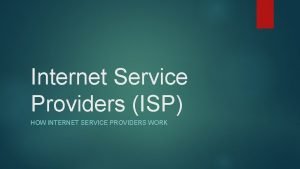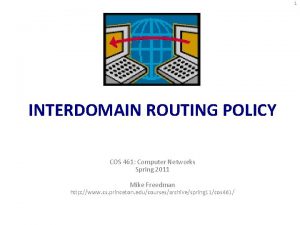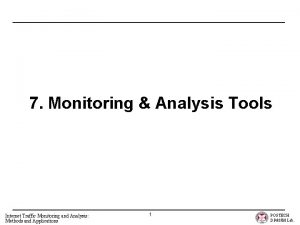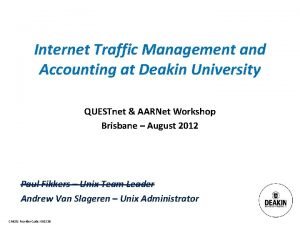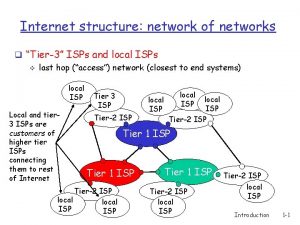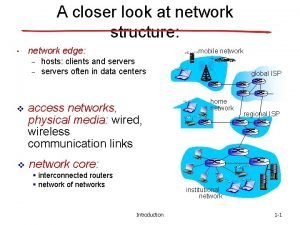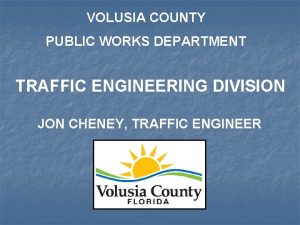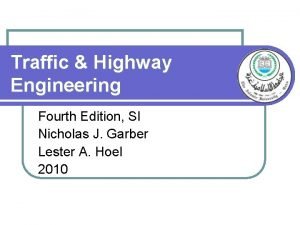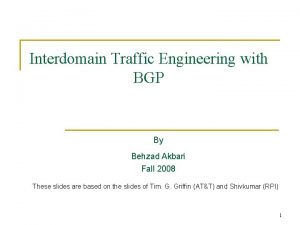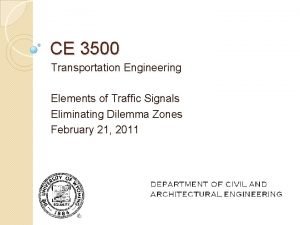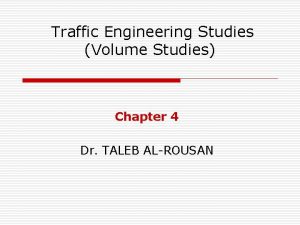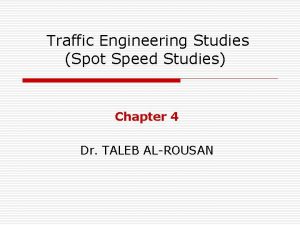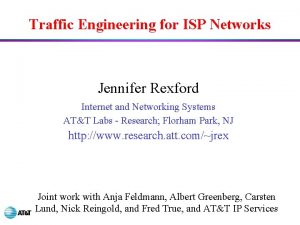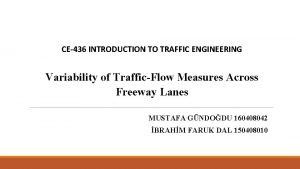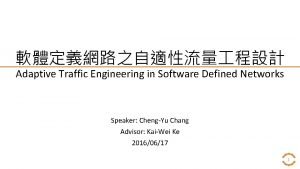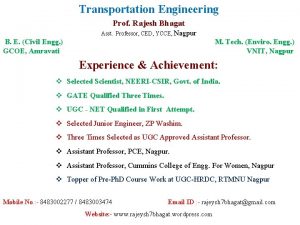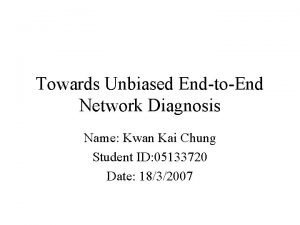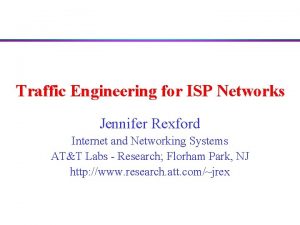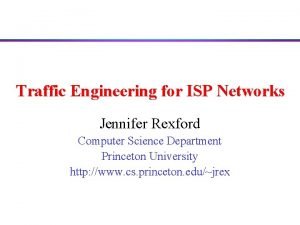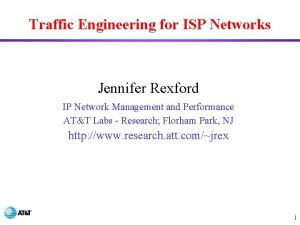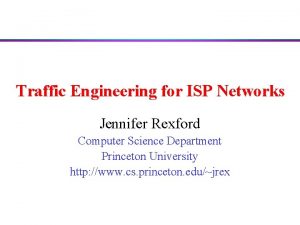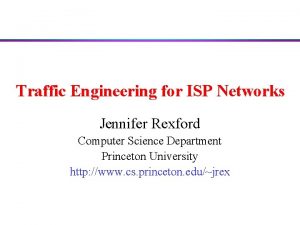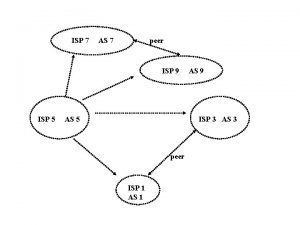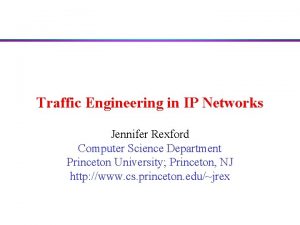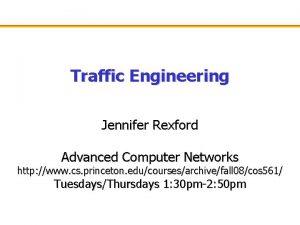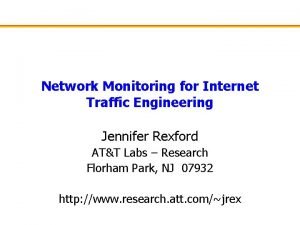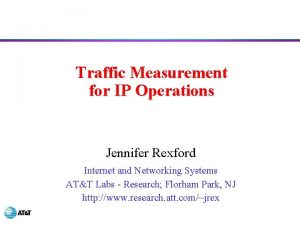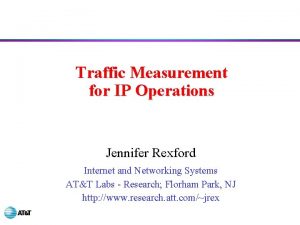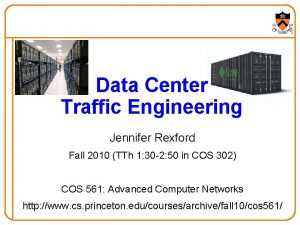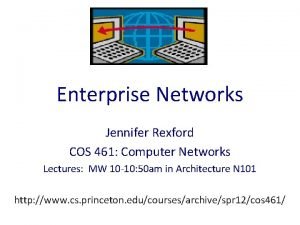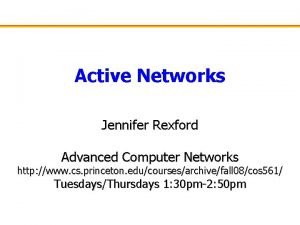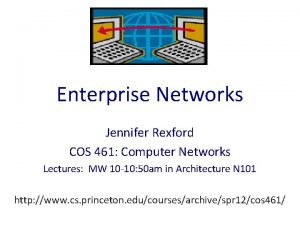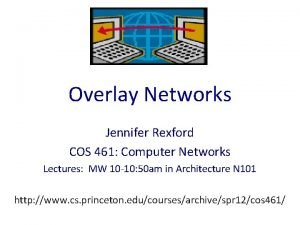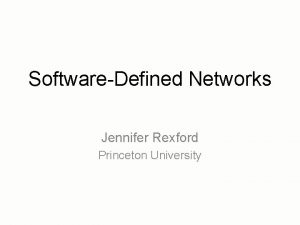Traffic Engineering for ISP Networks Jennifer Rexford Internet






























- Slides: 30

Traffic Engineering for ISP Networks Jennifer Rexford Internet and Networking Systems AT&T Labs - Research; Florham Park, NJ http: //www. research. att. com/~jrex Joint work with Anja Feldmann, Albert Greenberg, Carsten Lund, Nick Reingold, and Fred True, and AT&T IP Services

Outline u Background – Internet architecture – Interdomain and intradomain routing – Internet service provider backbone u Traffic engineering – Optimizing network configuration to prevailing traffic – Requirements for topology, routing, and traffic info u Traffic demands – Volume of load between edges of the network – Measurement methodology – Analysis of the demands on AT&T’s IP Backbone

Internet Architecture u Divided into Autonomous Systems – Distinct regions of administrative control (~6000 -7000) – Set of routers and links managed by a single institution – Service provider, company, university, … u Hierarchy of Autonomous Systems – Large, tier-1 provider with a nationwide backbone – Medium-sized regional provider with smaller backbone – Small network run by a single company or university u Interaction between Autonomous Systems – Internal topology is not shared between ASes – … but, neighboring ASes interact to coordinate routing

Autonomous Systems (ASes) Path: 6, 5, 4, 3, 2, 1 4 3 5 2 1 7 6 Web server Client

Characteristics of the Internet u The Internet is – Decentralized (loose confederation of peers) – Self-configuring (no global registry of topology) – Stateless (limited information in the routers) – Connectionless (no fixed connection between hosts) u These attributes contribute – To the success of Internet – To the rapid growth of the Internet – … and the difficulty of controlling the Internet!

Internet – Interconnection of Networks u Internet Protocol – Transmit a single packet from one host to another – Packet includes the IP address of the sender and receiver – Packets may be lost, delayed, or delivered out of order – Hosts perform retransmission and reordering of packets u IP address – 32 -bit IP addresses divided into octets (12. 34. 158. 5) – Allocated to institutions in contiguous blocks or prefixes – 12. 34. 158. 0/24 is a 24 -bit prefix with 28 IP addresses – Routing of IP packets in the Internet is based on prefixes

Interdomain Routing (Between ASes) u ASes exchange info about who they can reach u Local policies for path selection (which to use? ) u Local policies for route propagation (who to tell? ) u Policies configured by the AS’s network operator “I can reach 12. 34. 158. 0/24 via AS 1” “I can reach 12. 34. 158. 0/24” 1 12. 34. 158. 5 2 3

Internet Service Provider Backbone neighboring providers modem banks, business customers, web/e-mail servers How should traffic be routed through the ISP backbone?

Intradomain Routing (Within an AS) u Routers exchange information to learn the topology u Routers determine “next hop” to reach other routers u Path selection based on link weights (shortest path) u Link weights configured by AS’s network operator u … to engineer the flow of traffic 2 3 2 1 1 1 3 5 4 3

Traffic Engineering in an ISP Backbone u Topology of the ISP backbone – Connectivity and capacity of routers and links u Traffic demands – Expected/offered load between points in the network u Routing configuration – Tunable rules for selecting a path for each traffic flow u Performance objective – Balanced load, low latency, service level agreements … u Question: Given the topology and traffic demands in an IP network, which routes should be used?

State-of-the-Art in IP Networks u Missing input information – The topology and traffic demands are often unknown – Traffic fluctuates over time (user behavior, new appls) – Topology changes over time (failures, growth, reconfig) u Primitive control over routing – The network does not adapt the routes to the load – The static routes are not optimized to the traffic – Routing parameters are changed manually by operators (But, other than that, everything is under control…)

Example: Congested Link u Detecting that a link is congested – Utilization statistics reported every five minutes – Sample probe traffic suffers degraded performance – Customers complain (via the telephone network? ) u Reasons why the link might be congested – Increase in demand between some set of src-dest pairs – Failed router/link within the AS causes routing change – Failure/reconfiguration in another AS changes routes u How to determine why the link is congested? ? ? – Need to know the cause, not just the manifestations! u How to alleviate the congestion on the link? ? ?

Link Utilization: link color (high to low)

Requirements for Traffic Engineering u Models – Traffic demands – Network topology/configuration – Internet routing algorithms u Techniques for populating the models – Measuring/computing the traffic demands – Determining the network topology/configuration – Optimizing the routing parameters u Analysis of the traffic demands – Knowing how the demands fluctuates over time – Understanding the traffic engineering implications

Modeling Traffic Demands u Volume of traffic V(s, d, t) – From a particular source s – To a particular destination d – Over a particular time period t u Time period – Performance debugging -- minutes or tens of minutes – Time-of-day traffic engineering -- hours – Network design -- days to weeks u Sources and destinations – Individual hosts -- interesting, but huge! – Individual prefixes -- still big; not seen by any one AS! – Individual edge links in an ISP backbone -- hmmm….

Traffic Matrix Traffic matrix: V(in, out, t) for all pairs (in, out) in out

Problem: Multiple Exit Points u ISP backbone is in the middle of the Internet – Multiple connections to other autonomous systems – Destination is reachable through multiple exit points – Selection of exit point depends on intradomain routes u Problem with traditional point-to-point models – Want to predict impact of changing intradomain routing – But, a change in routing may change the exit point! 2 4 1 3

Traffic Demand u Definition: V(in, {out}, t) – Entry link (in) – Set of possible exit links ({out}) – Time period (t) – Volume of traffic (V(in, {out}, t)) u Computing the traffic demands – Measure the traffic where it enters the ISP backbone – Identify the set of exit links where traffic could leave – Associate traffic with the entry link and set of exit links – Aggregate over all traffic with same in, {out}, and t

Measuring Flows Rather Than Packets flow 1 flow 2 flow 3 flow 4 u. IP flow abstraction – Set of packets with “same” src and dest IP addresses – Packets that are “close” together in time (a few seconds) – The closest thing to a “call” in the Internet u. Cisco Net. Flow – Measure all flows between AT&T and neighbors – Extremely large amount of data (~100 GB/day)

Net. Flow Data u Source and destination information – Source and destination IP addresses (hosts) – Source and destination port numbers (application) – Source and destination AS numbers u Routing information – Source and destination IP prefix (network address) – Input and output links at this router u Traffic information – Start and finish time of flow (in seconds) – Total number of bytes and packets in the flow

Identifying Where the Traffic Can Leave u Traffic flows – Each flow has a dest IP address (e. g. , 12. 34. 156. 5) – Each address belongs to a prefix (e. g. , 12. 34. 156. 0/24) u Forwarding tables – Each router has a table to forward a packet to “next hop” – Forwarding table maps a prefix to a “next hop” link u Process – Dump the forwarding table from each router – Identify the entries where the “next hop” is an exit link – Identify the set of exit links associated with each prefix – Associate a flow’s dest address with the set of exit links

Locating the Set of Exit Links for Prefix d: exit links {i, k} i Table entry: (d, i) k d Table entry: (d, k)

Experimental Results: AT&T IP Backbone u Measurement for four days in November 1999 – Netflow data – Forwarding tables – Topology and routing configuration u Traffic analysis – Distribution of traffic volume across demands » Small % of demands are responsible for most traffic – Time-of-day fluctuations in traffic volumes » U. S. business, U. S. residential, International – Stability of traffic demands across hours and days » Initial results suggest some stability, but need to study

Proportion of Traffic in Top Demands (Log Scale)

Time-of-Day Effects (San Francisco)

Traffic-Engineering Implications u Small number of demands contribute most traffic – Can optimize routes for just the heavy hitters – Can measuring a small fraction of the traffic – Must watch out for changes in load and set of exit links u Time-of-day fluctuations – Reoptimize routes a few times a day (three? ) u Traffic (in)stability – Select routes that are good for different demand sets – Reoptimize routes after sudden changes in load

Traffic Flow Through AT&T’s IP Backbone Source node: public peering link (NAP) in New York Destination nodes: AT&T access routers Color/size of node: proportional to traffic to this router (high to low) Color/size of link: proportional to traffic carried (high to low)

Conclusions u Internet traffic engineering is hard – Decentralized (over 6000 Autonomous Systems) – Connectionless (traffic sent as individual packets) – Changing (topological changes, traffic fluctuations) u Traffic engineering requires knowing the demands – Interdomain traffic has multiple possible exit points – Demand as the load from entry to set of exit points – Not available from traditional measurement techniques u Measurement of traffic demands – Derivable from flow-level measurements at entry points – … and “next hop” forwarding info from exit points

Ongoing Work u Detailed analysis of traffic demands – Statistical properties (how to study stability? ) – Implications for traffic engineering u Online computation of traffic demands – Distributed flow-measurement infrastructure – Online aggregation of flow data into demands u Network operations (“operations” research? ) – Efficiently detecting sudden changes in traffic or routing – Optimizing routes based on topology and demands – Planning the design of the network over time – Getting the network to run itself…

Interesting Problems u Inferring the traffic demands from less information – sampling, active probes, inference from utilization u Optimizing routes subject to fluctuating demands – optimal routes per demand set vs. good for all sets u Techniques for analyzing stability of demand sets – multidimensional data (in, {out}, time) u Detecting shifts in the distribution of load – random changes vs. change in underlying distribution u Joint route optimization across multiple ASes – optimizing routes without divulging topology & traffic
 Assembly language instruction
Assembly language instruction Point of presence
Point of presence Gao rexford conditions
Gao rexford conditions Inbound traffic vs outbound traffic
Inbound traffic vs outbound traffic All traffic solutions
All traffic solutions Traffic management in computer networks
Traffic management in computer networks Datagram network diagram
Datagram network diagram Backbone networks in computer networks
Backbone networks in computer networks Internet traffic tool
Internet traffic tool Internet traffic management
Internet traffic management Internet transport protocol in computer networks
Internet transport protocol in computer networks Tier 3 isps
Tier 3 isps Internet structure network of networks
Internet structure network of networks Computer networks and internets with internet applications
Computer networks and internets with internet applications Which type of address is this: a3:34:45:11:92:f1
Which type of address is this: a3:34:45:11:92:f1 Osi vs tcp/ip
Osi vs tcp/ip Volusia county traffic engineering
Volusia county traffic engineering Traffic and highway engineering 4th edition
Traffic and highway engineering 4th edition Principles of intersection design
Principles of intersection design Bgp traffic engineering
Bgp traffic engineering Average delay in traffic engineering
Average delay in traffic engineering Elements of traffic engineering
Elements of traffic engineering Traffic engineering studies
Traffic engineering studies Speed study in traffic engineering
Speed study in traffic engineering Traffic engineering
Traffic engineering Introduction to traffic engineering
Introduction to traffic engineering Elements of traffic engineering
Elements of traffic engineering Traffic engineering network
Traffic engineering network Transportation engineering
Transportation engineering Internet or internet
Internet or internet Who isp
Who isp

